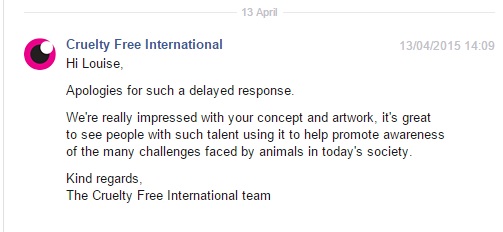Term 2: Mirror Monkeys
Posted: March 23, 2015 Filed under: Subject Leave a commentHaving experimented with different species of frequently used lab animal, I decided to only paint monkeys. I chose monkeys over other animals, as they are the most relatable animal; sharing many human characteristics. I felt this would be the best option in order to try and draw comparisons between human and animal.
I think my painting is improving as I get used to applying paint to mirror, and simply just getting back into practise with painting.
These mirrors are all different sizes and shapes. I shall try and get the same size and shaped mirrors so they are uniform.
Term 2: Contacting Animal Welfare Groups
Posted: March 7, 2015 Filed under: Contextualisation Leave a commentAfter the last tutorial, it was suggested to me that I send some of my work to animal welfare groups to try and receive some feedback from relevant organisations.
I composed the following message:
Dir Sir or Madam,
I am a third year Fine Art student at Cardiff Met, and this year I have based both my dissertation and subject work on the theme of animal rights and animal welfare.
For the exhibition at the end of the year, I am creating paintings to try and make people re-think their perceptions of animals. The paintings are done on mirrors – the eyes of the animals are left blank and mirrored to create a ‘thousand yard stare’ until the point when your own eyes are positioned correctly and reflect back at you. This will hopefully force people to draw comparisons between themselves and animals, and also give each person an individual interactive experience.
It was suggested to me that I contact animal welfare groups and gain some feedback on these ideas.
I have attached a few photographs of some sample paintings. If someone would be able to provide feedback in any context, it would be greatly appreciated.
Louise Davies.
I have sent this message, along with photographs of some examples of my paintings, to four organisations so far: Cruelty Free International, BUAV, and Anti-Fur Society via their Facebook groups, and Animal-Aid via their webpage.
UPDATE
I received a response from Cruelty Free International regarding my work:

Term 2: Yayoi Kusama
Posted: March 6, 2015 Filed under: Contextualisation Leave a commentDuring the formative assessment on ‘Ideas’, fellow student Rianna suggested looking at ‘The Passing Winter’ by Yayoi Kusama. This piece is a glass cube into which the viewer is invited to look. Inside, the cube is mirrored so that it reflects itself, the openings to look through, and even other viewers peering in. It’s a changing artwork; colours altering with the environment outside.
The infinite and endless reflections within the cube reminded me of a similar piece spanned over a whole room. On researching, I found it is actually also by Yayoi Kusama.
These infinite, continuous reflections add surreal depth and also confusion. Like a ‘hall of mirrors’ at a fair ground, these rooms are confusing – which are the real walls, and which are reflections?
Kusama’s work is making me think about re-reflecting my own work. Perhaps one painting reflected numerous times within a small room would feel claustrophobic, and effectively represent both the sheer volume of animals used in testing as well as the cramped, trapped conditions and excessive use of animals who are thought of only as statistics by so many.
Term 2: Jonty Hurwitz
Posted: March 5, 2015 Filed under: Contextualisation Leave a commentI have been trying to research artists who use mirrors within paintings. This has proven to be quite difficult; I have yet to find any artist who physically incorporates mirrors into painted pieces, or paints onto mirrors. However, Jonty Hurwitz uses mirrors in a different way.
Using acrylic, resin, powder and steel, Hurwitz creates elongated, distorted sculptures. Only on reflecting these sculptures in a convex mirror do you see what the sculpture really is; a frog.
I like the concept of things only being made sense of through the use of something else; this sculpture via the mirror. Without the mirror, the sculpture simply looks like a stretched piece of clay. My work doesn’t especially relate, but it does capture a similar idea; using a mirror to complete the artwork and add the final element. In this case, making sense of a sculpture. In my case, bringing the eyes of animal paintings to life.
Term 2 Formative Assessment Statement
Posted: March 1, 2015 Filed under: Subject Leave a commentTaking knowledge of successful advertising techniques gained by writing my dissertation, I have been trying to create disturbing paintings which make the viewer re-think their perception of the objectification and exploitation of animals without containing graphic or gory imagery of animal abuse which is likely to deter and put off the audience.
I have been trying to create work which integrates the viewer and forces them to become a part of the artwork. Interactivity is a proven method of capturing attention and increasing advertising recall. Using these methods may increase interest and gain integrity for my work.
The concept of my paintings is “putting yourself in the shoes of another”. By painting animal faces onto mirrors and leaving the eyes blank, the dead-eyed “thousand yard stare” suddenly springs to life when the viewer is positioned correctly and forced to see their own eyes staring back at them; bringing individuality to the work for each person who views it. Hopefully, the resulting effect will be at least a passing thought of empathy for the animals objectified and used as commodities, as comparisons are drawn between animal painting and human self.










Recent Comments